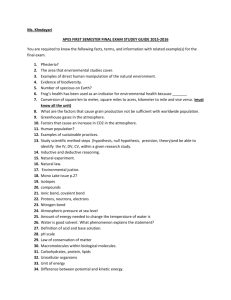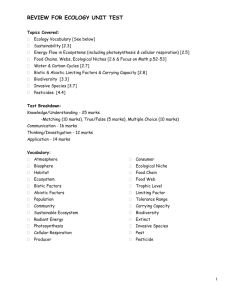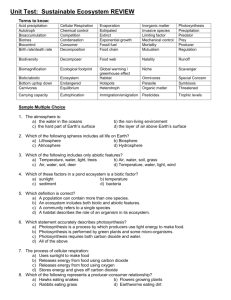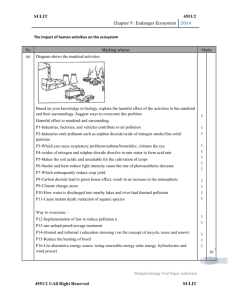ECOLOGY TEST REVIEW #1 Multiple Choice
advertisement
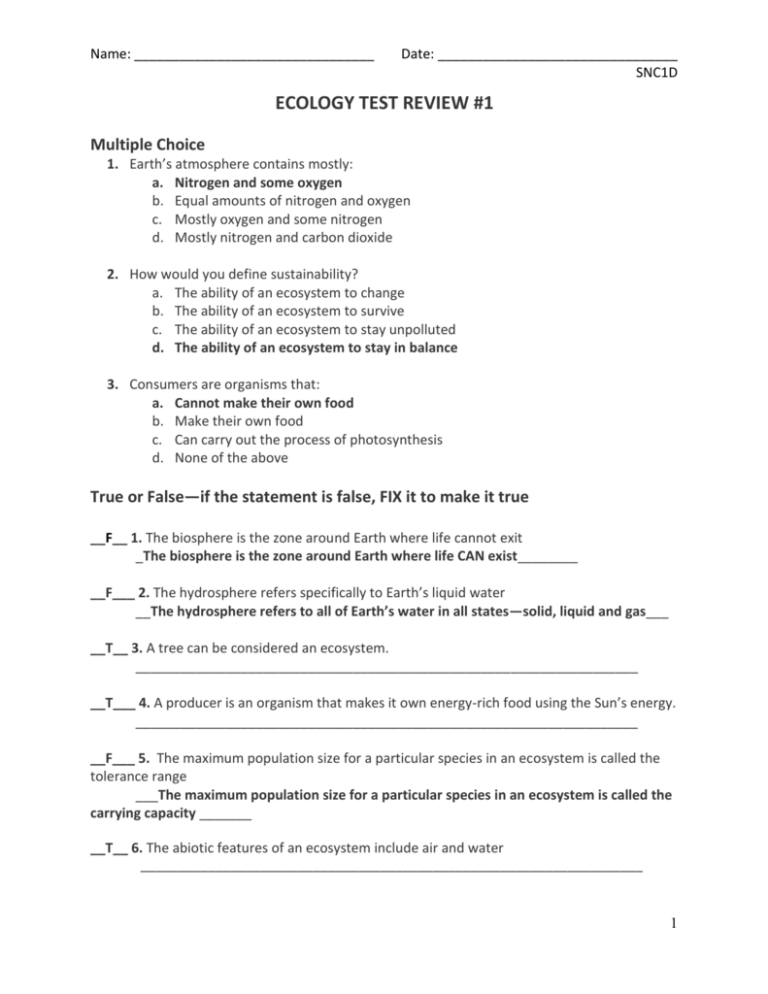
Name: ________________________________ Date: ________________________________ SNC1D ECOLOGY TEST REVIEW #1 Multiple Choice 1. Earth’s atmosphere contains mostly: a. Nitrogen and some oxygen b. Equal amounts of nitrogen and oxygen c. Mostly oxygen and some nitrogen d. Mostly nitrogen and carbon dioxide 2. How would you define sustainability? a. The ability of an ecosystem to change b. The ability of an ecosystem to survive c. The ability of an ecosystem to stay unpolluted d. The ability of an ecosystem to stay in balance 3. Consumers are organisms that: a. Cannot make their own food b. Make their own food c. Can carry out the process of photosynthesis d. None of the above True or False—if the statement is false, FIX it to make it true __F__ 1. The biosphere is the zone around Earth where life cannot exit _The biosphere is the zone around Earth where life CAN exist________ __F___ 2. The hydrosphere refers specifically to Earth’s liquid water __The hydrosphere refers to all of Earth’s water in all states—solid, liquid and gas___ __T__ 3. A tree can be considered an ecosystem. ___________________________________________________________________ __T___ 4. A producer is an organism that makes it own energy-rich food using the Sun’s energy. ___________________________________________________________________ __F___ 5. The maximum population size for a particular species in an ecosystem is called the tolerance range ___The maximum population size for a particular species in an ecosystem is called the carrying capacity _______ __T__ 6. The abiotic features of an ecosystem include air and water ___________________________________________________________________ 1 Name: ________________________________ Date: ________________________________ SNC1D Fill-in the Blanks 1. The Earth’s rocky outer layer is called the ___lithosphere_________________ 2. During photosynthesis, producers use light energy to convert ___carbon dioxide____ and water into high-energy sugar and oxygen 3. As you move up from one trophic level to the next, the amount of available energy _________decreases____________. 4. Abiotic factors such as temperature, light and soil can influence a species’ ability to survive or its ___tolerance_____ range. 5. The abiotic conditions of intertidal zones alternate between those of terrestrial ecosystem and those of a(n) ______aquatic_____ ecosystem Matching __2___ a) Tundra __3___ b) grassland __4___ c) boreal forest __1___ d) temperate deciduous forest 1) longer growing season, higher temperatures, fertile soil, many large trees 2) low temperatures, short growing season, permafrost 3) longer growing season, higher temperatures, fertile soil, grasses 4) no permafrost, conifer trees, acidic soil Short Answer Questions 1. How is cellular respiration related to photosynthesis? Cellular respiration is the opposite process of photosynthesis. Photosynethesis is makes sugar and oxygen out of carbon dioxide and water. Cellular respiration makes carbon dioxide and water out of sugar and oxygen. 2. Why is there abundant life in shallow waters near the shore? Shallow waters near the shore are nutrient rich and there is lots of sunlight for photosynthesis for lots of plants. Lots of plants make good homes for small animals 2 Name: ________________________________ Date: ________________________________ SNC1D 3. Look at this simple food chain: grass rabbit coyote. Could it be part of a food web? Explain. Yes it could be part of a food web because food webs contain many food chains. A food web would show other animals that eat grass and other animals that eat the rabbit 4. Identify two human activities that can influence the carbon cycle. Any of the following is an acceptable answer: 1) Humans respire and release carbon dioxide into the air 2) Humans burn fossil fuels which releases carbon dioxide into the ar 3) Humans decompose and release carbon back into the soil Can you think of anything else? 5. What are the five key abiotic factors that determine which species can live in particular aquatic ecosystems? Light, nutrients, water temperature, acidity, salt levels 3

